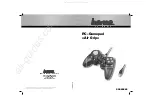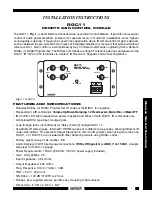
6.6.1 Universal Inputs
The universal inputs on the DXM100-Bx Wireless Controller can be programmed to accept several different types of inputs:
•
Discrete NPN/PNP
•
0 to 20 mA analog
•
0 to 10 V analog
•
10k temperature thermistor
•
Potentiometer sense
•
Bridge
•
NPN raw fast
Any input can be used as a synchronous counter by configuring the input as a discrete NPN/PNP input.
Use the DXM Configuration Tool tool to write to the appropriate Modbus registers in the I/O board to configure the input
type. The universal inputs are treated as analog inputs. When the universal inputs are defined as mA, V, or temperature,
use Modbus registers to configure the operational characteristics of the inputs. These parameters are temperature
conversion type, enable full scale, threshold and hysteresis. Refer to the DXM100 Controller Instruction Manual (p/n
) for the parameter definitions.
When a universal input is configured as an NPN or PNP input type, it can be enabled to be a synchronous counter. Enable
the counter function by setting Modbus register 'Enable Rising' or 'Enable Falling' to 1. See
on page 31 for universal input register definitions.
Pin
Universal Input
Modbus Register
Description
27
4
4
Program the universal inputs to accept input types NPN, PNP, 10k thermistor, 0 to 10 V, 0 to 20
mA, or potentiometer. The default setting is 8: NPN raw fast. To set the input type, write the
following values to the Input Type Modbus registers defined in
on page 31.
0 = NPN
1 = PNP
2 = 0 to 20 mA
3 = 0 to 10 V dc
4 = 10k Thermistor
5 = Not used
6 = Not used
7 = Bridge
8 = NPN Raw Fast (default)
28
3
3
31
2
2
32
1
1
Thermistor Input
A thermistor input must use a 10k temperature thermistor between ground and the universal input. The
thermistor must be a 10k NTC (Banner model number BWA-THERMISTOR-002) or equivalent. Select the
temperature conversion of degrees C (default) or degrees F by writing Modbus registers defined in
Registers for the DXM100-B1 I/O Base Board
on page 31.
Potentiometer Input
A potentiometer input is created from three inputs: a voltage source (pin 30) that supplies 5 V to the
potentiometer and two inputs set to voltage inputs to read the voltage across the potentiometer. See the DXM
tech note for setting up a potentiometer.
Bridge Input
The bridge input is not implemented yet.
NPN vs NPN Raw Fast
The difference between NPN and NPN Raw Fast is the amount of settling time given to the input. Switch the input
type to NPN if the input is not detecting a transition.
Synchronous Counters
When an input is configured as a counter (inputs set to NPN/PNP), the input counts the input signal transitions.
The count value is stored into two 16-bit Modbus registers for a total count of 32-bits (unsigned). To program an
input to capture the edge transition counts, follow
Example: Configure Input 1 as a Synchronous Counter
on page
30.
Synchronous counter sample the inputs every 10 ms. The input logic does not detect rising or falling edges, but
instead samples the input every 10 ms to find level changes. The input signals must be high or low for more than
10 ms or the input will not detect transitions. Because most signals are not perfect, a realistic limit for the
synchronous counter would be 30 to 40 Hz.
Example: Configure Input 1 as a Synchronous Counter
1. Connect the DXM Controller to the PC.
2. Launch the DXM Configuration Tool software.
3. Connect to the DXM Controller by selecting the Device > Connection Settings menu option. You may connect using
either USB or Ethernet.
DXM100-Bx Wireless Controller Instruction Manual
46
www.bannerengineering.com - Tel: 763.544.3164
















































